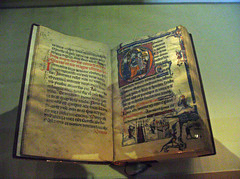 As promised, I’m giving you a summary of the Wesley Forum I attended on April 7.
As promised, I’m giving you a summary of the Wesley Forum I attended on April 7.
Lecturer Dr Ben Witherington focused his 3 lectures on The Imago Dei (Image of God)
The 1st session had to do with the Imago Dei seen through archeology.
He spoke about the huge dig at a high place found in Turkey, in 1993, called Gobeckli (click for amazing National Geographic photos and info).
This is probably one of the most significant discoveries since the Rosetta Stone–and I hadn’t even heard of it. Have you?
It invalidates the typical (secular) ideas of how religious and spiritual life emerged among humans.

Social Anthropologists have, until now, thought that religion came after people began farming and wanted to gain control of their unpredictable environment.
It worked like this…so they thought…
• Human stumbles on a new kind of mutated wheat that be more easily harvested.
• They kept the seeds and settled in areas to raise crops.
• They struggled against the harsh elements and began to think of wind, sun, rain, etc as superpowers (i.e. gods)…(superstitious folks).
• They tried to please and apprise the gods to gain better circumstances…and…
• Boom…religion.
You’ve heard this theory before, right?
To Witherington, this recent discovery shows that the need to reconcile with the divine is part of the human experience, not an invention that came at the advent of the agricultural age.
The religion of these high places helped begin civilization, not the other way around.

The oldest part of the Gobeckli site is dated to 10,000-12,000 years ago and is the oldest temple ever found in the world.
That’s old…but how old?
Wrap your brain around this!
It was created before people were living in villages, farming, and before they had domesticated any animals (sheep, dogs, cattle, etc).
People were wandering, gathering, hunting, and trying to connect to the divine…the whole time.
As the highest point in the region and situated between the Tigris and Euphrates Rivers, I can’t help but wonder if Cain and Able used this very place. It could be just east of Eden. (LD)
Now, think of the age of this place this way:
The site dates to about 6,000 years before the Great Pyramids were created. It’s a time that precedes writing, by thousands of years.
And yes, it’s pre-Noah and the flood.
Giant monoliths, the largest weighing about 50 tons (¡ yikes !), depict a host of detailed carvings of animals. There are also some stylized carvings of people dressed in priestly vestments. Even more tremendous are the enormous erected stones which have holes drilled into them to tie up animals.
But, remember this is a pre-bronze age. Pre-iron age.
How long did it take to make a hole such as this in this rock with just another rock?
These structures are made in a sophisticated fashion. Cave people were smarter than we assume.
It’s astonishing.

But there are not just 1 of these 30 m. circles with 13 massive stones …they have found 17 of them.
Each takes about 3 years to unearth. (Things are just starting to get interesting! In 50 years they still will not be finish. Much more surprises could be in store.)
Here’s the wikipeda article about the site.
According to archeologists on the dig, the site was eventually backfilled (purposefully) at a point in human development when villages were being established. It seems that local temples were used at that point.
NOTE: (Witherington believes they were not backfilled purposefully, but that the flood (in Noah’s time) moved sand up to the place from the Tigris River. I, personally, think that the flood would have ruined them and that they were indeed backfilled purposefully [for what specific reason, I don’t know]. To me, this burying is what preserved them so well so we could now find them intact. It’s a crazy amount of work to do such a thing, and I don’t know how they could, but the whole site baffles our understanding, so I haven’t ruled it out.)
Dr Witherington concludes that because of the image of God within us, we desire to commune with God (or gods). We always have.
All the ancient people groups had 3 things:
1. Temples
2. Priests
3. Sacrifices
I will elaborate more on the lectures in the next post and include some of my notes from the other 2 sessions.
Read PART II
Read PART III
Enjoying what you’re reading?
Get delivery…straight to your inbox; join several hundred fans and sign up in the sidebar.





